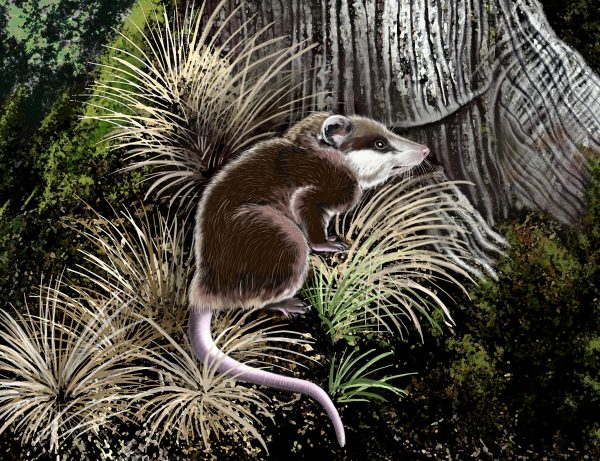A Florida Museum researcher has co-authored a study tracing the evolution of the modern opossum back to the extinction of the dinosaurs and finding evidence to support North America as the center of origin for all living marsupials.
The study, to be published in PLoS ONE on Dec. 16, shows that peradectids, a family of marsupials known from fossils mostly found in North America and Eurasia, are a sister group of all living opossums. The findings are based in part on high-resolution CT scans of a 55-million-year-old skull found in freshwater limestone from the Bighorn Basin of Wyoming.

Illustration by Jorge A. Gonzalez, courtesy of Paläontologisches Institut und Museum Universität Zürich
“The extinction of the dinosaurs was a pivotal moment in the evolution of mammals,” said Jonathan Bloch, study co-author and associate curator of vertebrate paleontology at the Florida Museum of Natural History. “We’re tracing the beginnings of a major group of mammals that began in North America.”
Opossum-like peradectids first appeared on the continent about 65 million years ago, at the time of the Cretaceous-Paleogene extinction event, which killed the dinosaurs.
“North America is a critical area for understanding marsupial and opossum origins because of its extensive and varied fossil record,” said lead author Inés Horovitz, an assistant adjunct professor at the University of California, Los Angeles. “Unfortunately, most of its species are known only from teeth.”
The study also analyzes two 30-million-year-old skeletons of Herpetotheriidae, the sister group of all living marsupials.
Based on fossil evidence from the skull and two skeletons, the study’s authors concluded the evolutionary split between the ancestor of opossums and the ancestor of all other living marsupials occurred at least 65 million years ago, Horovitz said.
Marsupials migrated between North and South America until the two continents separated after the end of the Cretaceous period. Marsupials in South America diversified and also migrated into Antarctica and Australia, which were still connected at that time, Bloch said.
North American marsupials went extinct during the early Miocene, about 20 million years ago. But after the Isthmus of Panama emerged to reconnect North and South America 3 million years ago, two marsupials made it back to North America: the Virginia opossum (Didelphis virginiana), a common resident in the Southeast today, and the southern opossum (Didelphis marsupialis), which lives as far north as Mexico.

Illustration by Jorge A. Gonzalez, courtesy of Paläontologisches Institut und Museum Universität Zürich
The study describes a new peradectid species, Mimoperadectes houdei, based on a relatively complete fossil skull. The high-resolution CT scan of the skull gave researchers a large amount of information about the animal’s internal anatomy. The ear, in particular, provides researchers with information on skull anatomy and clues about the animal’s locomotion, Bloch said.
The scan showed the new species shared enough common traits with living opossums to indicate an evolutionary relationship. Some predictions about that relationship could have been made from fossil teeth, Bloch said, “but this provides a much stronger foundation for that conclusion.”
Most North American marsupials living in the Paleocene and early Eocene (56 million to 48 million years ago) were small-bodied animals. But M. houdei approached the body size of some opossums living today.
“You would probably recognize it as an opossum, but it wouldn’t look quite right,” Bloch said.
The skull came from the same limestone deposits in Wyoming as the primitive primate skull Bloch and other researchers used to map an early primate brain with CT scans in a study published earlier this year.
“In parts of North America today, opossums are one of the most commonly observed mammals around,” Bloch said. “This fossil skull shows its roots going back to the extinction of the dinosaurs. This is literally the fossil that shows us the ancestry of that animal.”
The study’s examination of the two skeletons gives a first glimpse into the form and structure of primitive marsupials and shows that they were more terrestrial than modern opossums. The skeletons came from the late Oligocene and were found in the White River Badlands of Wyoming.
The international research team also included Thomas Martin (University of Bonn, Germany), Sandrine Ladevèze and Marcelo Sánchez-Villagra (University of Zurich, Switzerland), and Cornelia Kurz (Natural History Museum, Kassel, Germany).
Read the full study online at PLOS ONE.